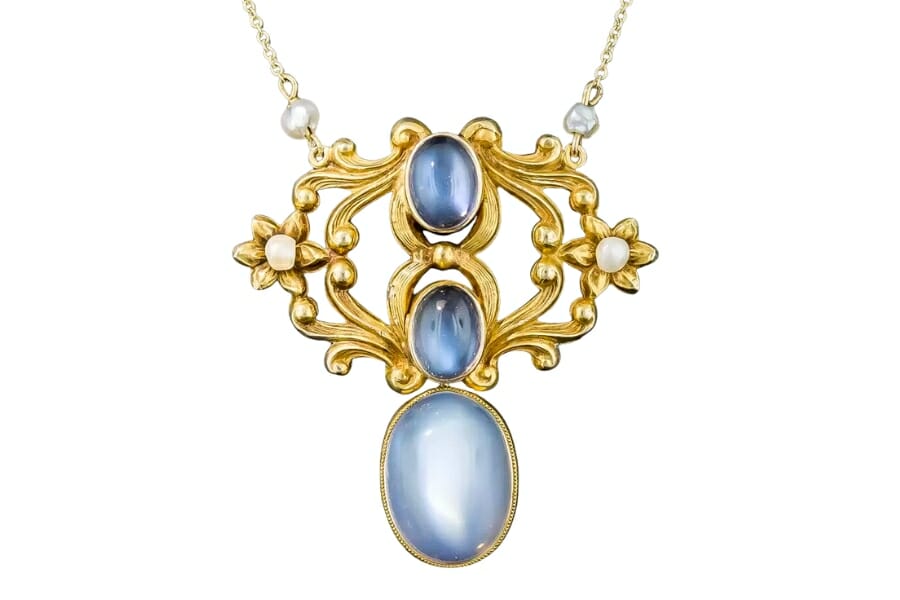Known for its otherworldly glow and enchanting properties, Moonstone has captured the hearts of many gemstone enthusiasts and collectors. But what makes this precious gemstone so special?
Moonstone has long been associated with lunar energies, intuition, and femininity for centuries. With its captivating beauty, it’s not hard to see why. But Moonstone isn’t just a pretty face. It’s also believed to have many powerful properties, such as calming the mind, enhancing intuition, and promoting emotional healing.
Whether you wear it as jewelry or keep it close to you as a talisman, Moonstone is sure to bring a sense of serenity and magic to your life. Read on to discover more about the wondrous world of Moonstone and its true value.
What Moonstone Is
Moonstone is a type of mineral that belongs to the feldspar group. It’s named after its characteristic appearance, which resembles the soft, ethereal glow of the moon.
The glow that Moonstone is known for is caused by a phenomenon called Adularescence, which occurs when light enters the stone and scatters off the thin, alternating layers of feldspar minerals that make up the gemstone. The result is a glowing, almost magical effect that seems to come from within the stone itself.
Moonstone can come in a range of colors that has specific price tags of its own, as we will discuss below.
White Moonstone
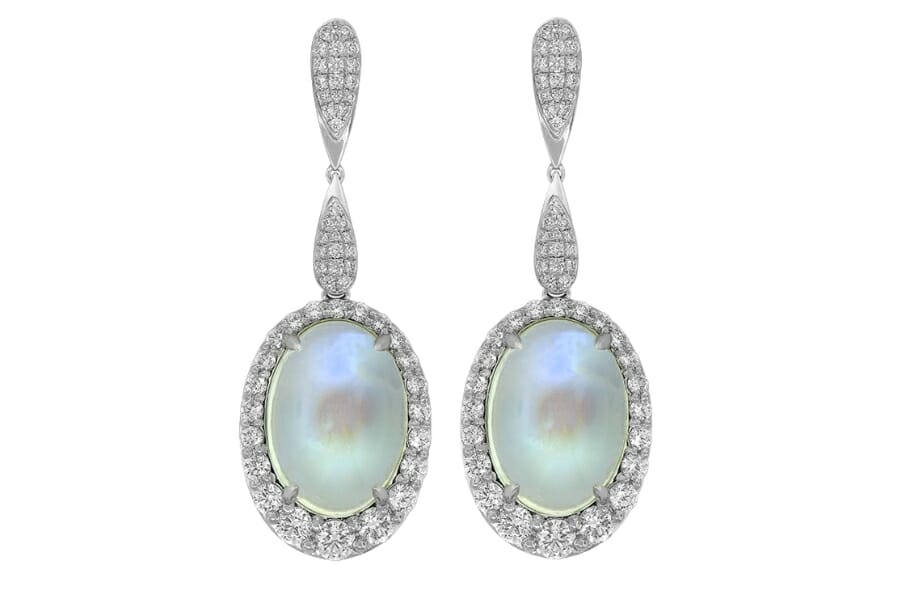
As its name suggests, White moonstone is characterized by its white or colorless appearance. It’s known for its iridescent, almost magical sheen that looks like moonbeams on water.
White moonstones are often used in jewelry making, particularly in rings and pendants. Their subtle, shimmering beauty makes them a popular choice for brides looking for something special and unique to wear on their wedding day.
How much is White Moonstone worth
A White Moonstone’s price is set at $4 to $75 per carat, which is considered high compared to other colors of this gemstone.
Blue Moonstone
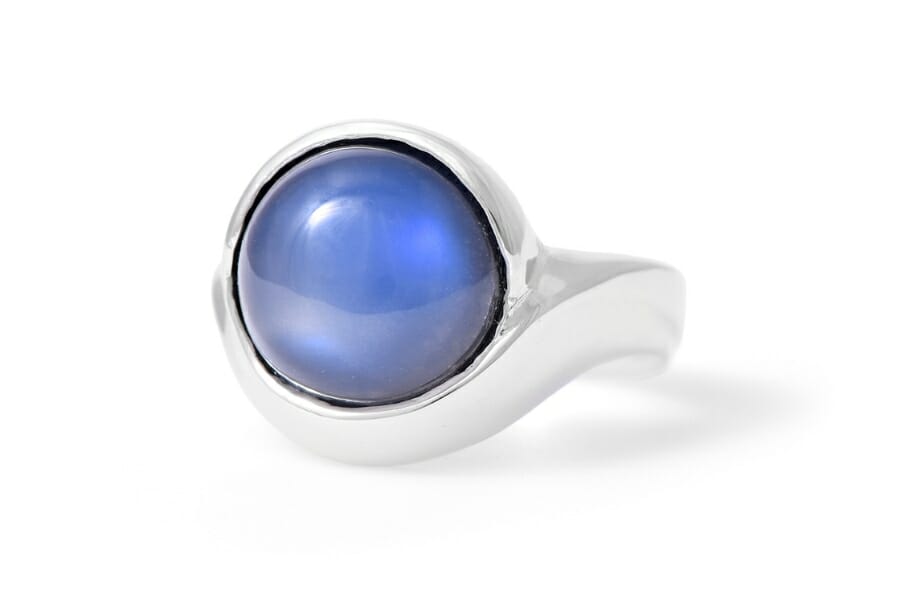
Distinguished by its blue to bluish-gray color, Blue Moonstones are typically found in Sri Lanka and are often referred to as “Ceylonese Moonstones.” Like all Moonstones, this color type is known for their enchanting adularescence.
Blue Moonstone is considered to be particularly powerful in the realm of emotional healing. It’s believed to promote calmness, inner peace, and harmony. It’s also said to enhance intuition and spiritual awareness, helping the wearer to connect with their innermost self and with the divine.
How much is Blue Moonstone worth
Just like the other colored Moonstone types, Blue Moonstone tends to sell lower than the white variety, with a price of $0.8 to $12 per carat.
Green Moonstone
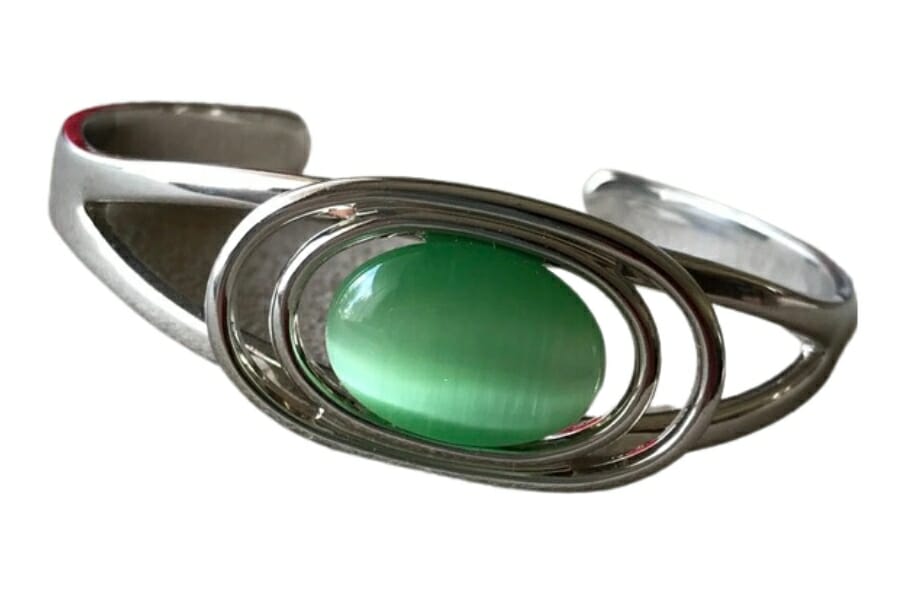
Green Moonstone is rarer than the more common white and blue ones, and it’s often found in Madagascar and Tanzania.
This gemstone is prized for its unique beauty, which comes from their iridescent sheen, created by the alternating layers of feldspar minerals within the stone. The green hue can range from a pale, minty color to a deep, emerald shade, and can vary in intensity depending on the light.
How much is Green Moonstone worth
Like the blue variety, a Green Moonstone’s price is set at $0.8 to $12 per carat.
Pink Moonstone
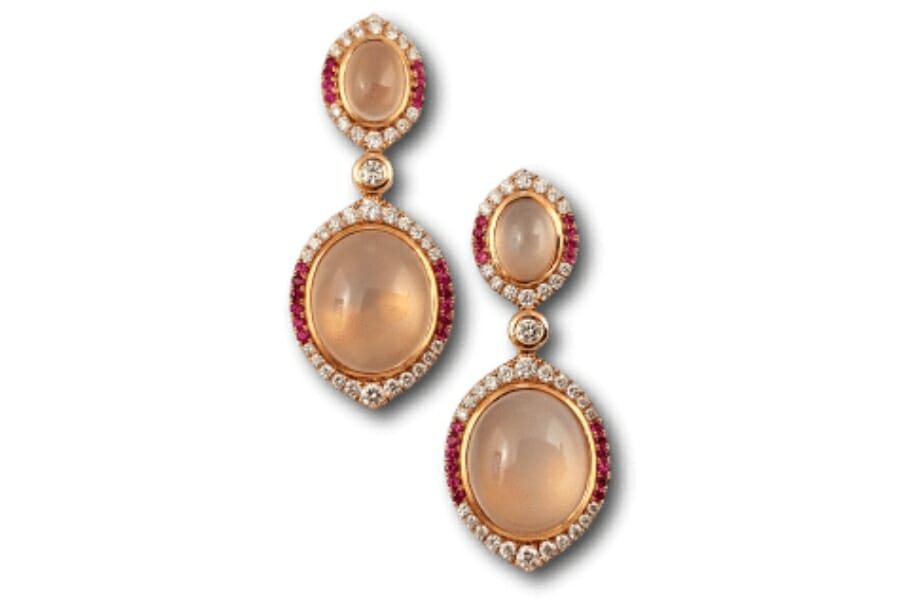
With its pink or peach hue, Pink Moonstone is definitely a sight to behold. It’s found in various parts of the world, including Sri Lanka, India, and Madagascar.
Like all Moonstones, this pink variety is known for its enchanting Adularescence. The pink hue can vary from a delicate blush to a vibrant coral, depending on the quality of the stone and the light conditions. Because of its color, Pink Moonstone is believed to promote love, compassion, and emotional balance. It’s said to help heal emotional wounds and promote a sense of inner peace and calmness.
How much is Pink Moonstone worth
A Pink Moonstone’s price is set at $0.8 to $12 per carat, just like its other colored counterparts.
Cat’s Eye Moonstone
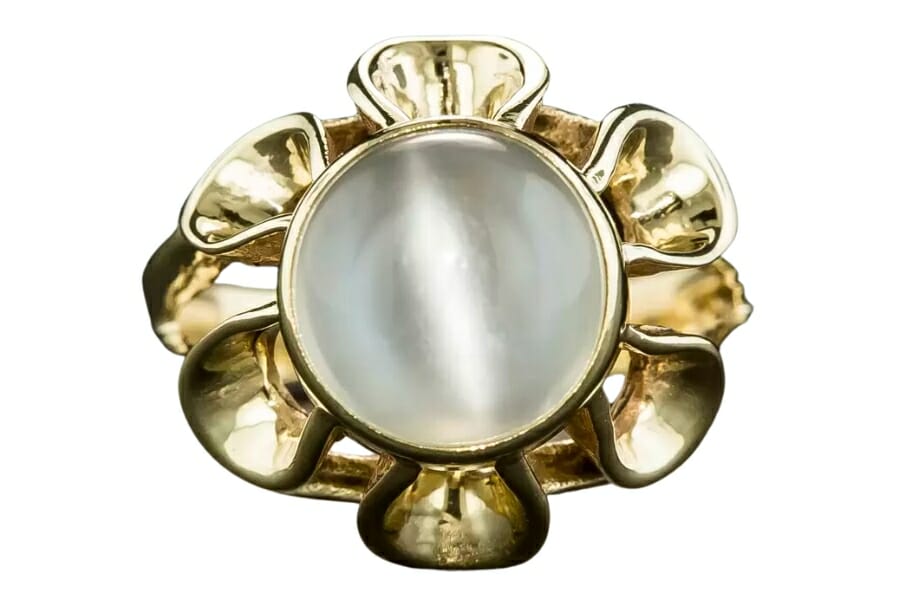
Cat’s Eye Moonstone is characterized by a unique optical phenomenon called chatoyancy, which creates a glowing band of light across the surface of the stone that looks like the slit pupil of a cat’s eye. This effect is caused by the reflection of light off the parallel inclusions within the stone, which create a narrow band of light that moves across the surface as the stone is rotated.
This type of Moonstones are typically found in Sri Lanka, India, and Madagascar, and can range in color from white to gray to brownish-yellow. In jewelry making, it’s a popular choice for those seeking something unique and eye-catching. Its striking chatoyancy effect is especially stunning when paired with gold or platinum.
How much is Cat’s Eye Moonstone worth
Cat’s Eye Moonstone is highly prized as evidenced by its price at $16 to $150 per carat.
Star Moonstone
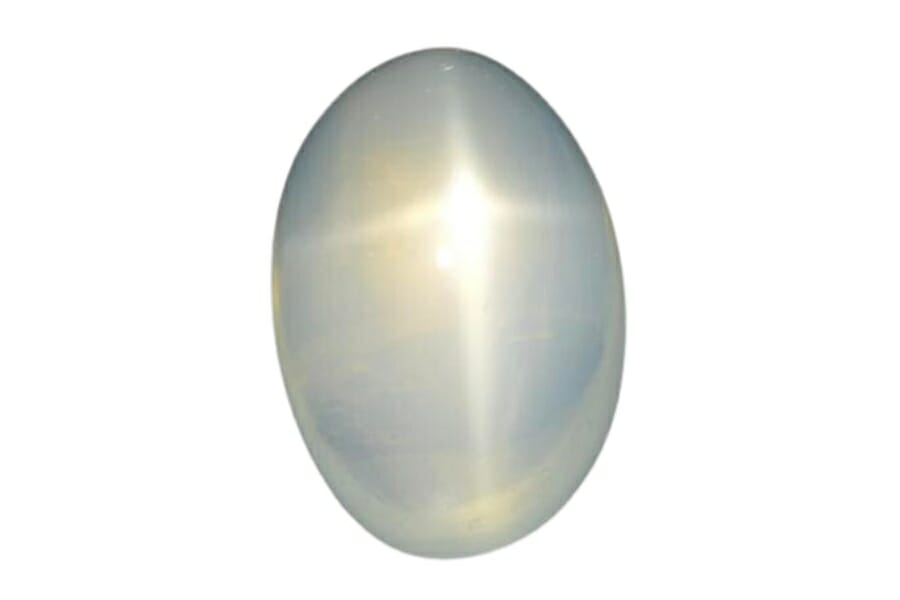
Star Moonstone displays a unique optical phenomenon known as asterism, which creates a star-like pattern across the surface of the stone. This effect is caused by the reflection of light off the parallel inclusions within the stone, which create a six-rayed star that moves across the surface as the stone is rotated.
Ranging in color from white to gray to brownish-yellow, Star Moonstones are typically found in Sri Lanka, India, and Madagascar. Like all Moonstones, this type is believed to have spiritual and emotional healing properties, helping to promote balance, calmness, and intuition.
How much is Star Moonstone worth
Since Star Moonstone is rare, it costs more than the other colored Moonstones. Current prices of this type are set at $2 to $45 per carat.
Why Moonstone Is So Expensive
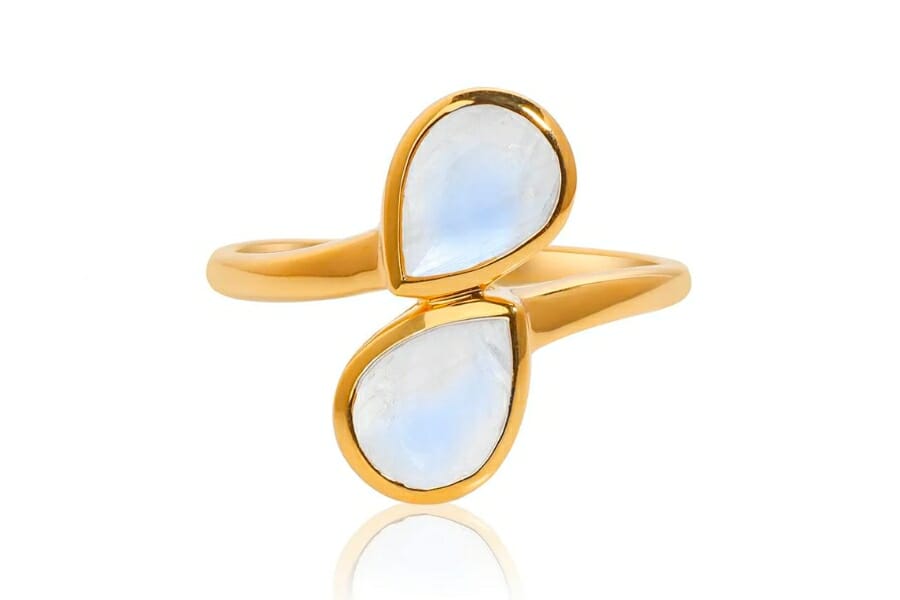
Moonstone has been valued for centuries due to its ethereal beauty and enchanting properties. It’s said to promote inner peace, calmness, and intuition, making it a popular choice for those seeking spiritual and emotional healing.
But why is Moonstone so expensive? Let’s dive in and explore the reasons behind its high value.
First of all, Moonstone is a relatively rare gemstone, which contributes to its high price tag. While it can be found in various parts of the world, including Sri Lanka, India, Madagascar, and the United States, high-quality ones are hard to come by.
The finest Moonstones have a clear body color with a strong, vivid Adularescence that seems to glow from within, and these stones are highly sought after by collectors and connoisseurs.
Secondly, Moonstone requires a great deal of skill and expertise to cut and shape properly. Because of its unique properties, including its softness and tendency to cleave, it must be handled with care and precision during the cutting process.
This requires a skilled lapidary who understands its intricacies and who can bring out its best qualities.
Lastly, this gemstone’s popularity and demand also play a role in its high value. As more and more people become interested in alternative and holistic healing practices, the demand for Moonstone has grown. This has led to an increase in prices as supply struggles to keep up with demand.
How To Determine The Value Of Moonstone
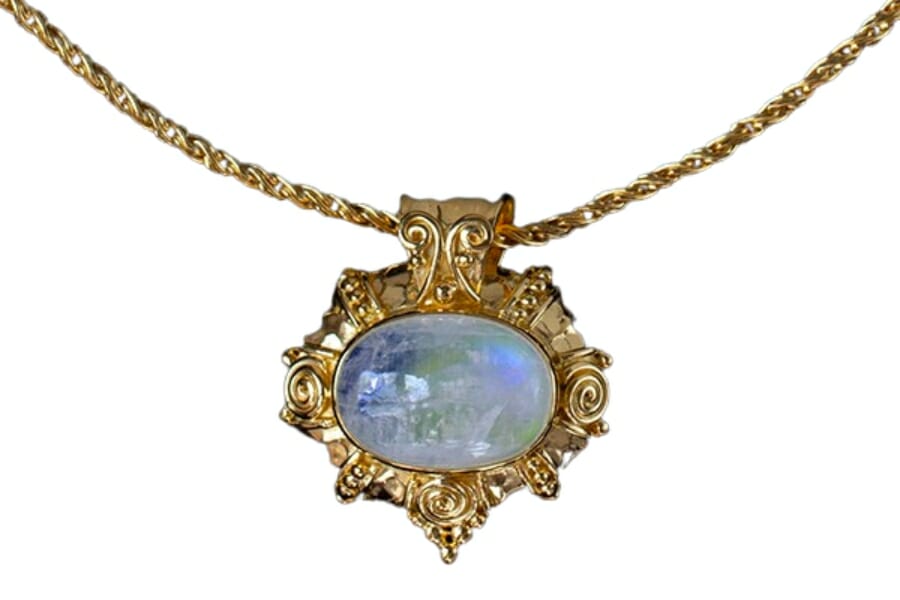
Moonstone has different qualities that play as factors in its price and value in the market. Most important of these are the following:
Adularescence
We’ve been mentioning Adularescence since the beginning of this article and for good reason. This unique optical phenomenon is specific to Moonstone, and it plays a significant role in determining its value.
The finest Moonstones exhibit a strong, vivid adularescence that appears to glow from within the stone. These stones are highly valued by collectors and connoisseurs for their otherworldly beauty and rarity.
Moonstones with weaker or less visible adularescence are considered lower quality and therefore less valuable.
Color
As we’ve discussed above, Moonstones occur in a range of colors, and some of these colors are more highly valued than others.
For example, a pure White Moonstone with a blue adularescence is considered the classic and most highly valued specimen, while a white Moonstone with a yellow, orange, or brown body color may be considered lower quality and therefore less valuable.
The intensity and evenness of the color can also impact a Moonstone’s price. Those with strong, even colors are considered more valuable than those with a weaker, uneven color distribution.
Clarity
The clarity of a Moonstone refers to the absence of inclusions or internal flaws that can affect its transparency and overall appearance. The clearer and more transparent it is, the more valuable it’s considered to be.
Moonstones with a high degree of transparency and minimal inclusions are rare and therefore more valuable. In contrast, those with visible inclusions, cracks, or cloudy areas are considered lower quality and may have a lower value. But there are certain inclusions that make this gemstone more valuable, as we’ll discuss below.
Inclusions (Chatoyancy and Asterism)
Inclusions such as chatoyancy and asterism can significantly impact the price of a Moonstone, making them highly prized.
Moonstones with a strong chatoyancy or cat’s eye effect are rare and highly valued by collectors, with their value increasing depending on the intensity and evenness of the effect. Meanwhile, the value of Moonstones with strong asterism effect increase depending on the number and position of the intersecting inclusions.
Cut
An important consideration when cutting a Moonstone (that can affect its price, too) is its overall shape and proportions. Moonstones can be cut into a variety of shapes, including cabochons, beads, and faceted stones.
The chosen shape should complement its natural characteristics and bring out its best qualities. For example, a cabochon cut can enhance the stone’s Adularescence, while a faceted cut can bring out the stone’s transparency and play of color.
Carving and Jewelry Setting
When a Moonstone is carved into a decorative shape, such as a figurine or sculpture, it can become a highly sought-after collector’s item, with its value based on the skill and creativity of the carver, as well as the rarity and quality of the stone.
Similarly, when a Moonstone is set into a piece of jewelry, such as a ring, pendant, or earrings, it can become a valuable and desirable piece of wearable art. The design and quality of the setting can greatly impact the value of the piece, with high-quality materials, skilled craftsmanship, and unique design elements increasing the overall value of the jewelry.
The type of metal used (e.g. gold, platinum, silver, brass, etc.) can also impact the overall value of the Moonstone.
Size
Unlike with diamonds, the carat weight of a Moonstone does not have as significant an impact on its value, since they’re typically found in smaller sizes compared to other gemstones.
But larger Moonstones can command a higher price compared to smaller ones. However, the price increase due to carat weight alone is typically not as significant compared to other factors.
Treatment
Some Moonstones are treated with a coating or dye to enhance their color or Adularescence. While such treatments can improve its appearance, they can also diminish its value, as they are not considered natural and can be less durable than untreated stones.
Untreated Moonstones, on the other hand, are highly valued and can command a higher price.
Moonstone Price By Color and Inclusion
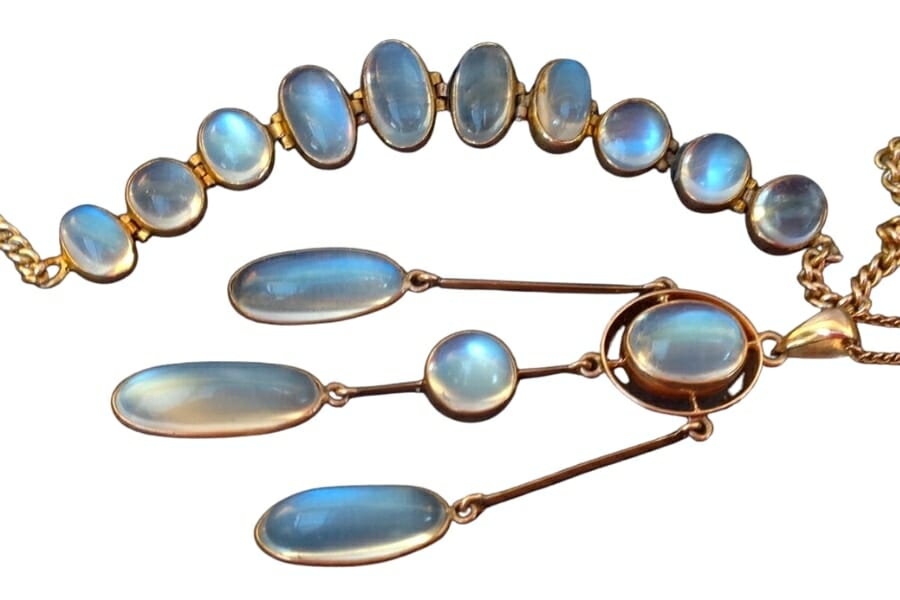
The color and inclusions greatly affect a Moonstone’s value, so these are the most common bases for its varying prices.
Below are the current market values of Moonstone according to color and inclusion:
Moonstone values by color
| Color | Price (Per Carat) |
| White | $4 – $75 |
| Blue | $0.8 – $12 |
| Green | $0.8 – $12 |
| Pink | $0.8 – $12 |
Moonstone values by inclusion
| Type | Price (Per Carat) |
| Cat’s Eye Moonstone | $16 – $150 |
| Star Moonstone | $2 – $45 |
To give you a clearer picture how much Moonstone is really worth, we did a fun calculation of its price depending on several units of measurement.
Moonstone pricing by unit of measurement
| Measurement | Price |
| A carat of Moonstone | $0.08 – $150 |
| A gram of Moonstone | $0.40 – $750 |
| An ounce of Moonstone | $11 – $21,262 |
| A kilogram of Moonstone | $400 – $750,000 |
| A pound of Moonstone | $181 – $340,194 |
| A ton of Moonstone | $362,874 – $680,388,750 |
The Most Expensive Moonstone
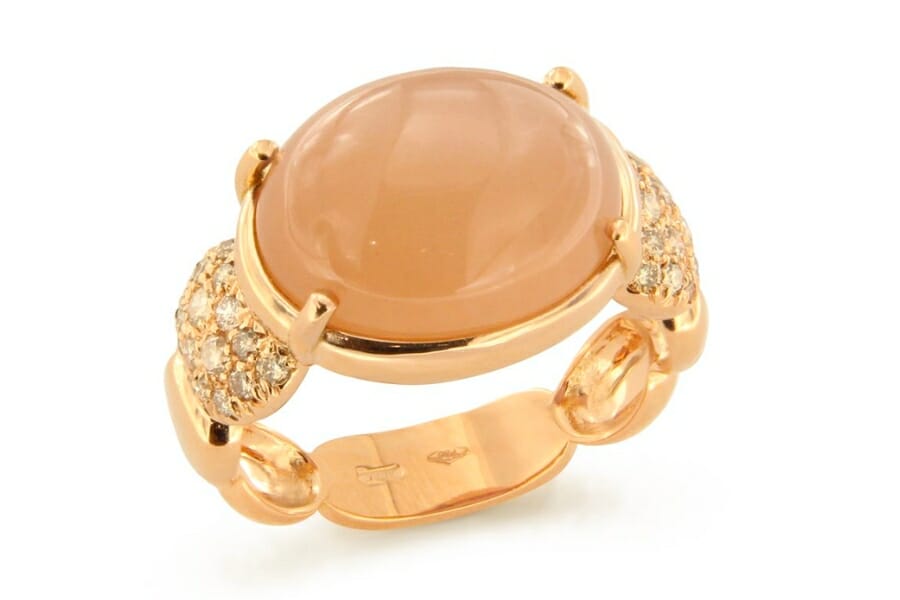
There is no concise record of the most expensive Moonstone ever sold is, as its value can vary greatly depending on their specific characteristics and the market conditions at the time of sale.
However, there have been several notable specimens that have fetched high prices at auctions and in private sales.
One example is a 50-carat, rare, Blue Moonstone from Sri Lanka that sold for $496,000 at a Christie’s auction in 2013. It featured a unique, pear-shaped cut and a strong, blue Adularescence that shifted with the light. Its rarity, size, and high-quality color and Adularescence all contributed to its high value.
Another example is a 28.86-carat pink Moonstone that sold for $216,000 at a Sotheby’s auction in 2017. The stone has a cabochon cut and a strong Adularescence, like the first example.
How To Get An Appraisal On Your Moonstone
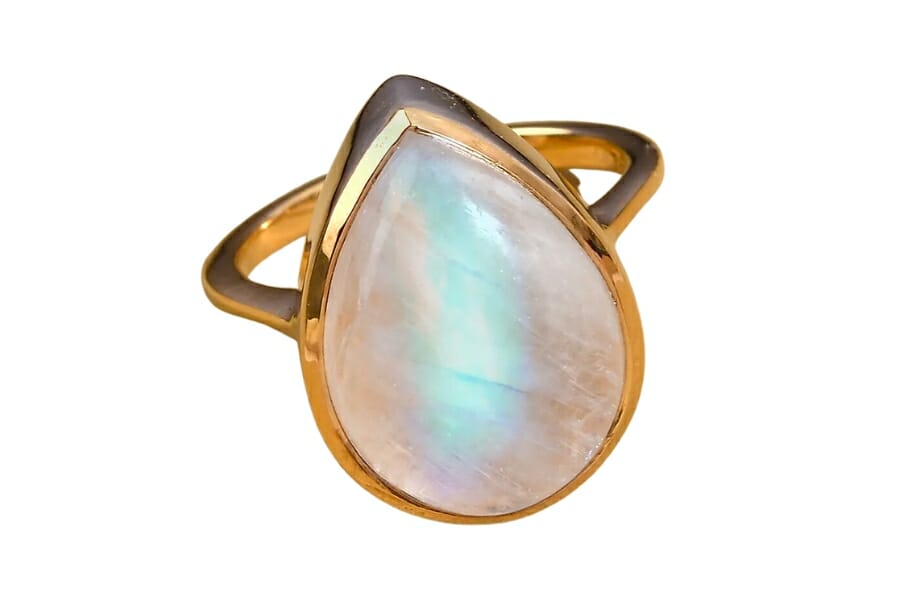
If you’re looking to get an appraisal on your Moonstone, there are a few things you can do to ensure that you get an accurate and fair assessment of its value.
Firstly, it’s important to choose a reputable appraiser who has experience working with Moonstones and other gemstones. Look for appraisers who are certified by professional organizations, such as the Gemological Institute of America (GIA) or the American Gem Society (AGS).
Before you bring your Moonstone in for an appraisal, it’s a good idea to clean it thoroughly and examine it for any visible flaws or inclusions. This can help the appraiser assess its clarity and overall condition.
When you meet with the appraiser, be sure to provide as much information about the gemstone as possible, including its carat weight, cut, color, and any other relevant details. If you have a certificate of authenticity or any other documentation about the stone, bring this along as well.
Finally, be prepared to receive a range of values for your Moonstone, as its worth can vary based on a number of factors. It’s also important to remember that an appraisal is just an opinion of the stone’s value, and ultimately the price it sells for will be determined by the market demand and other external factors.

